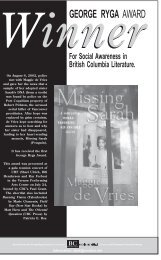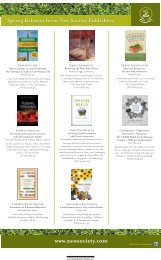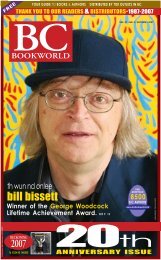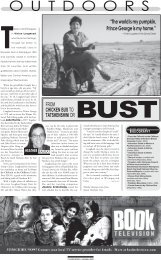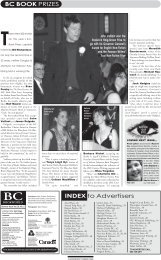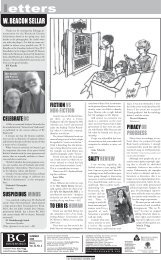Autumn 2011 Volume 25 - No 3 - BC BookWorld
Autumn 2011 Volume 25 - No 3 - BC BookWorld
Autumn 2011 Volume 25 - No 3 - BC BookWorld
Create successful ePaper yourself
Turn your PDF publications into a flip-book with our unique Google optimized e-Paper software.
20 <strong>BC</strong> BOOKWORLD • LOOKOUT • AUTUMN • <strong>2011</strong><br />
21 <strong>BC</strong> BOOKWORLD • LOOKOUT • AUTUMN • <strong>2011</strong><br />
art<br />
Mary George, 1943 (top);<br />
Willie Seaweed, 1946 (bottom).<br />
Mildred Valley Thornton & Emily Carr<br />
Mildred Valley Thornton,<br />
circa 1920s<br />
BY DAVID STOUCK<br />
Mask Dance of the<br />
Bella Coolas, 1943<br />
Sheryl Salloum’s The Life and Art of Mildred Valley Thornton (Mother Tongue<br />
$35.95) challenges the assumption that Emily Carr stands alone. Historically<br />
these roughly contemporary B.C. painters have been compared<br />
because they were women and because they painted this province’s landscapes<br />
and Native subjects. But the comparison has not been kind to Thornton who<br />
has been dismissed as technically inferior and lacking an artistic vision.<br />
When researching her subject Salloum<br />
showed Gordon Smith photos of Thornton’s<br />
work. She tells us he was surprised by how “really,<br />
really good” Thornton is. “She did not make<br />
pretty pictures” like most women of that era, he<br />
observed: “she was gutsy.” Smith’s response is key<br />
to this book and its place in Mona Fertig’s<br />
important “Unheralded Artists of <strong>BC</strong>” series because,<br />
as part of a younger generation that included<br />
B.C. Binning and Jack<br />
Shadbolt, Smith had dismissed Thornton<br />
chiefly because she was not moving towards abstraction.<br />
As art critic for the Vancouver Sun she<br />
had carried the banner for representational art<br />
into the 1940s and 50s and seemed dated, out<br />
of touch. But Smith now sees her work differently,<br />
as containing something of “the freshness<br />
of Tom Thomson,” and has pronounced certain<br />
pieces such as the remarkable Hao Hao<br />
Dance of the Bella Coolas as “terrific.”<br />
Terrific is also a way of describing the production<br />
values of this fourth volume in the<br />
“Unheralded” series: selected watercolours and<br />
oils have been given excellent reproduction to<br />
highlight the vibrancy of their rich colours and<br />
the painter’s bold brush strokes. Thornton may<br />
not have embraced abstraction, but she was thoroughly<br />
modern when she highlighted the act of<br />
painting itself by making visible the rough textures<br />
of paint and brush, this post-impressionist<br />
technique is especially evident in the<br />
book’s cover scene of boats at<br />
Kitsilano Beach.<br />
Salloum gives us a lucid, engaging<br />
account of the artist’s life.<br />
Mildred Valley Thornton (1890-<br />
1967), the seventh in a farm family<br />
of fourteen children, was born and<br />
raised in southern Ontario, attended<br />
classes at the Ontario College of Art<br />
Sheryl Salloum<br />
Mildred Valley Thornton in<br />
her Vancouver studio, 1959<br />
and, like Carr, had some training in the United<br />
States. In 1913, when she was 23, she moved on<br />
her own to Regina where she met her future husband<br />
and established herself as one of Saskatchewan’s<br />
prominent artists. But the Depression<br />
ruined her husband’s restaurant business and<br />
they relocated with twin sons to Vancouver in<br />
1934 where Thornton immersed herself in the<br />
city’s artistic and cultural communities. Her generous,<br />
outgoing personality and energetic style<br />
were the opposite of the shy and abrasive Emily<br />
Carr. Forthright and sociable, she was a devoted<br />
wife and mother, and enjoyed friendly relations<br />
with her clients and members of the community.<br />
But she was like Carr in that she was a woman<br />
determined to realize her ambitions as an artist.<br />
Especially important to that goal were her relations<br />
with First Nations. Salloum gives us a very<br />
balanced view of those relations. Thornton admired<br />
and respected Native people<br />
and worked hard to dispel negative<br />
stereotypes on their behalf, but in today’s<br />
terms her efforts were limited<br />
by being outside the culture. For example,<br />
she advocated for better educational<br />
opportunities, but did not<br />
recognize the destructive nature of<br />
residential schooling. Her retelling of<br />
Native myths and stories was unintentionally<br />
romantic and patronizing.<br />
At the same time her admiration and respect<br />
for Native people was at the heart of what she<br />
regarded as her life’s mission—to paint portraits<br />
of as many Native elders as possible. Like Carr,<br />
she wanted to record a way of life she feared was<br />
disappearing and, again like Carr, she went on<br />
long expeditions to find her subjects. She travelled<br />
wherever she could get a ride, toting her<br />
heavy supplies, and sometimes her young sons<br />
along. The result was more than <strong>25</strong>0 portraits of<br />
the Native people of western Canada. It was what<br />
she considered to be the heart of her life’s work,<br />
but it also became the source of heartache. Her<br />
goal was to find a gallery or government agency<br />
that would buy her “Collection,” but as she was<br />
excluded from the art establishment none was to<br />
be found. In her last years, Salloum tells us, she<br />
experienced the kind of discouragement that Carr<br />
knew much of her life, and in a codicil to her<br />
will she directed that her First Nations portraits<br />
either be auctioned off or destroyed. Fortunately<br />
that codicil was improperly witnessed and the<br />
work remained intact.<br />
✍<br />
ULTIMATELY, THORNTON AND CARR SHOULD NOT BE<br />
compared because, in what is perhaps their best<br />
work, they do very different things. Carr, who<br />
painted few portraits, moved beyond Native ma-<br />
terials to paint the forests and the skies. Here lies<br />
her transcendental, what some might call self-absorbed,<br />
romantic vision. Thornton’s vision, on the<br />
other hand, remained earth-bound. She created<br />
her monumental collection of Native portraits,<br />
but went on in her larger canvases to portray the<br />
activities of the aboriginal people—carving, whaling,<br />
assembling for potlatch, engaging in ceremonies,<br />
dancing. She is especially good at portraying<br />
women at work—cleaning fish, erecting teepees<br />
on the plains. These were different subjects and<br />
required different technical skills.<br />
✍<br />
THERE IS AN UNFORTUNATE NOTE IN AN OTHERWISE<br />
informative foreword supplied by Sherrill<br />
Grace. She writes that for every major artist<br />
like Emily Carr there are hundreds of artists like<br />
Thornton who play minor roles in the development<br />
of an art form, its appreciation by the public,<br />
and its acquisition by less wealthy art lovers.<br />
To keep Thornton in the shadows this way is exactly<br />
what Salloum’s book does not want to do.<br />
Rather it is designed to celebrate a painter whose<br />
work is unique and to extend the boundaries for<br />
making judgments about art. This Salloum does<br />
exceptionally well. 978-1-896949-05-5<br />
David Stouck is a novelist, short story writer<br />
and the biographer of Ethel Wilson.



